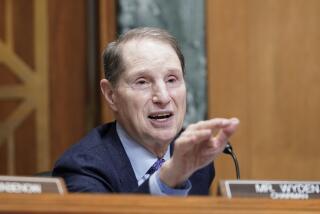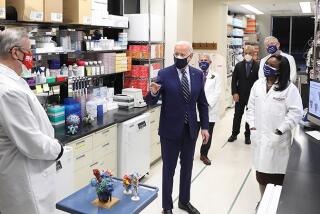Letters to the editor
Scanning the options
Re “The high cost of precision,” Sept. 7
By overstating the growth of CT scanning, The Times’ article paints an inaccurate picture of how physicians use this lifesaving technology.
The Government Accountability Office statistics used to demonstrate an increase in CT scans are misleading. The GAO’s report did not use 2007 data, which show that medical imaging’s growth has actually decreased.
The article also presents biased information as fact in order to claim CT over-utilization. Insurance companies are motivated to reduce healthcare costs, including imaging, and have created a cottage industry, called radiology benefit managers, with the sole purpose of refusing coverage for scans. By citing subjective insurance-company-generated analysis of how many scans are “inappropriate,” readers are presented with a skewed view of how and why physicians order scans.
The larger issue is ensuring that patients have access to the right scan at the right time. That’s why it is vital to ensure that healthcare decisions remain between physicians and patients. The recent Medicare bill embraces this through accreditation and appropriateness criteria. These approaches help ensure that each scan is appropriate and effective without denying access.
Maureen Zilly
Arlington, Va.
The writer is the director of government relations for the Medical Imaging and Technology Alliance.
I want to congratulate The Times for educating the public about the risks of CT scanning, particularly in children. As a pediatric surgeon, I have spent the last seven years educating my colleagues, as well as future physicians, about these risks, and pleading with them to use CT scanning more judiciously.
Unfortunately, outside scattered islands of excellence, American medicine is becoming an increasingly corporate affair, where assembly-line care is practiced and clinical acumen and judgment are giving way to routine and chaotic use of technology. In such an environment, patient benefit and professional ethics often take a back seat to financial profits. Our nonsystem of healthcare is desperately sick, and your article describes one of its many symptoms.
We can initiate the recovery of our healthcare system by banning the practice of physician self-referral and enacting policies that restore medicine as a service, not a business.
Sherif Emil, MD
Irvine
Energy priorities must change
Re “The Geo Metro as dream machine,” Column One, Sept. 9
So some people are driving 30-year-old cars that get much better gas mileage than today’s automobiles. Such vehicles, because of their scarcity, are unavailable to most of us. What to do then?
Many of us are in the position of owning a gas guzzler that, despite eliciting an ouch on every fill-up, is still too young to be scrapped. Should we sell it, buy a hybrid and get a warm feeling for helping save the planet?
It sounds good at first, but what about the person who buys our big car? He or she will continue, presumably, to drive it, and use as much fuel, or perhaps more, than we did.
Far better to find a good mechanic and keep our big car running as long as possible, thereby helping the local economy, and to change driving habits so we accomplish multiple errands on one trip. We will still say ouch, but less frequently.
Dick Jackson
Arroyo Grande
As a former Geo Metro owner and current Toyota Prius driver, I know my situation of 18 years of 40-mpg-or-better mileage is unusual. The fact is, though, that we can do so much better and have just fundamentally lacked the will to change.
In the 1920s, there were experimental cars with hybrid and compressed-air technologies, although they were primitive and not commercially viable. Even the Ford Model T averaged about 25 mpg. Yet here we are, 80 years later, and we’ve made little progress in moving away from the use of the internal combustion engine. Not even the wake-up call of the 1970s energy crisis could scare the country into making meaningful headway.
Now an even greater urgency is upon us, but the majority’s hue and cry is to drill for more oil offshore and in Alaska. Why a country that so often demonstrates amazing technological prowess remains unable to muster the support needed for transformative change is mystifying.
Tellingly, a 1925 issue of the Los Angeles-based industry publication, “The Oil Age,” included a short article on why European cars were so much more fuel efficient than domestic ones. The reason? We Americans placed our priority on power.
GM program engineer Al Manzor’s comment that cars that don’t race to 60 mph in seven seconds or less are not competitive reveals just how little our priorities have changed. The crux now is that, long term, we don’t have the luxury of deferring hard choices.
Paul R. Spitzzeri
Chino Hills
It’s fanaticism
Re “The American secessionist streak,” Opinion, Sept. 10
Christopher Ketcham airily dismisses Sarah Palin’s chumminess with the Alaskan Independence Party and her husband’s seven-year membership in it as nothing worse than “that loveliest of American predilections, our crotchety contrarianism.”
The last time a large number of Americans decided that the government was “broken and cannot be fixed” by traditional means, it was because they were determined to keep blacks enslaved. That fanaticism, which resulted in more than 200,000 American deaths, was a bit more than “crotchety.”
Today, as we face global challenges such as climate change and expansionist Russia and China, the idea of dismantling America is beyond quaint. It’s dangerous stupidity.
If 20% of Americans today see nothing wrong with secession, then the extreme right wing’s ongoing war to undercut public education (particularly in the realms of history and civics) is bearing plentiful, if rotten, fruit.
Doug Molitor
Monterey Hills
Math problem
Re “The almost 1% solution,” editorial, Sept. 10
Cute editorial on the clever way 99 Cents Only Stores handled its inevitable price increase without losing its identity, but your math only comes close to being 100% correct.
A 0.99-cent increase is not “a price hike that approaches 1%,” it equals 1% exactly. Simple math: 101% of 99 is 99.99. Or 99.9900000000 -- without rounding, the need for a parabolic curve or anything else.
So it is not, as the headline reads, an “almost 1% solution.” Whether it solves the balance-sheet concerns remains to be seen, as I assume costs have risen far more than the price hike reflects. But if it helps, that would make it almost a solution, not almost 1%.
Christopher Hoffman
Long Beach
More to Read
A cure for the common opinion
Get thought-provoking perspectives with our weekly newsletter.
You may occasionally receive promotional content from the Los Angeles Times.






